Hengxu He
Exploring the Spatiotemporal Features of Online Food Recommendation Service
Aug 08, 2023Abstract:Online Food Recommendation Service (OFRS) has remarkable spatiotemporal characteristics and the advantage of being able to conveniently satisfy users' needs in a timely manner. There have been a variety of studies that have begun to explore its spatiotemporal properties, but a comprehensive and in-depth analysis of the OFRS spatiotemporal features is yet to be conducted. Therefore, this paper studies the OFRS based on three questions: how spatiotemporal features play a role; why self-attention cannot be used to model the spatiotemporal sequences of OFRS; and how to combine spatiotemporal features to improve the efficiency of OFRS. Firstly, through experimental analysis, we systemically extracted the spatiotemporal features of OFRS, identified the most valuable features and designed an effective combination method. Secondly, we conducted a detailed analysis of the spatiotemporal sequences, which revealed the shortcomings of self-attention in OFRS, and proposed a more optimized spatiotemporal sequence method for replacing self-attention. In addition, we also designed a Dynamic Context Adaptation Model to further improve the efficiency and performance of OFRS. Through the offline experiments on two large datasets and online experiments for a week, the feasibility and superiority of our model were proven.
Multi-Granularity Attention Model for Group Recommendation
Aug 08, 2023Abstract:Group recommendation provides personalized recommendations to a group of users based on their shared interests, preferences, and characteristics. Current studies have explored different methods for integrating individual preferences and making collective decisions that benefit the group as a whole. However, most of them heavily rely on users with rich behavior and ignore latent preferences of users with relatively sparse behavior, leading to insufficient learning of individual interests. To address this challenge, we present the Multi-Granularity Attention Model (MGAM), a novel approach that utilizes multiple levels of granularity (i.e., subsets, groups, and supersets) to uncover group members' latent preferences and mitigate recommendation noise. Specially, we propose a Subset Preference Extraction module that enhances the representation of users' latent subset-level preferences by incorporating their previous interactions with items and utilizing a hierarchical mechanism. Additionally, our method introduces a Group Preference Extraction module and a Superset Preference Extraction module, which explore users' latent preferences on two levels: the group-level, which maintains users' original preferences, and the superset-level, which includes group-group exterior information. By incorporating the subset-level embedding, group-level embedding, and superset-level embedding, our proposed method effectively reduces group recommendation noise across multiple granularities and comprehensively learns individual interests. Extensive offline and online experiments have demonstrated the superiority of our method in terms of performance.
BASM: A Bottom-up Adaptive Spatiotemporal Model for Online Food Ordering Service
Nov 22, 2022Abstract:Online Food Ordering Service (OFOS) is a popular location-based service that helps people to order what you want. Compared with traditional e-commerce recommendation systems, users' interests may be diverse under different spatiotemporal contexts, leading to various spatiotemporal data distribution, which limits the fitting capacity of the model. However, numerous current works simply mix all samples to train a set of model parameters, which makes it difficult to capture the diversity in different spatiotemporal contexts. Therefore, we address this challenge by proposing a Bottom-up Adaptive Spatiotemporal Model(BASM) to adaptively fit the spatiotemporal data distribution, which further improve the fitting capability of the model. Specifically, a spatiotemporal-aware embedding layer performs weight adaptation on field granularity in feature embedding, to achieve the purpose of dynamically perceiving spatiotemporal contexts. Meanwhile, we propose a spatiotemporal semantic transformation layer to explicitly convert the concatenated input of the raw semantic to spatiotemporal semantic, which can further enhance the semantic representation under different spatiotemporal contexts. Furthermore, we introduce a novel spatiotemporal adaptive bias tower to capture diverse spatiotemporal bias, reducing the difficulty to model spatiotemporal distinction. To further verify the effectiveness of BASM, we also novelly propose two new metrics, Time-period-wise AUC (TAUC) and City-wise AUC (CAUC). Extensive offline evaluations on public and industrial datasets are conducted to demonstrate the effectiveness of our proposed modle. The online A/B experiment also further illustrates the practicability of the model online service. This proposed method has now been implemented on the Ele.me, a major online food ordering platform in China, serving more than 100 million online users.
Spatiotemporal-Enhanced Network for Click-Through Rate Prediction in Location-based Services
Sep 20, 2022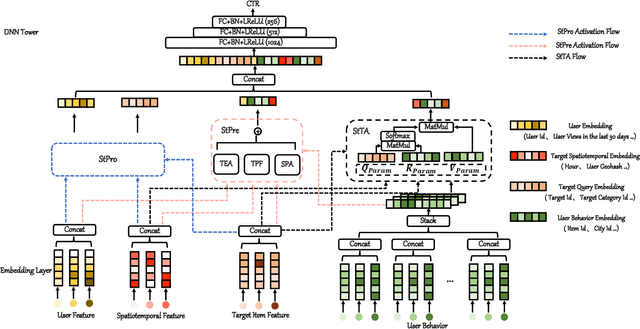
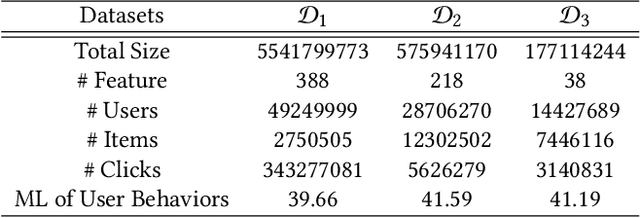
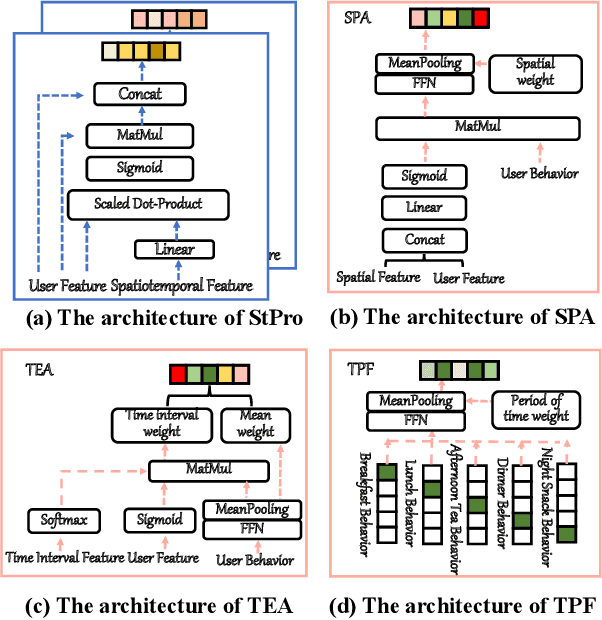
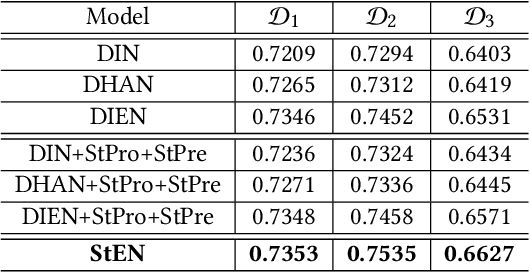
Abstract:In Location-Based Services(LBS), user behavior naturally has a strong dependence on the spatiotemporal information, i.e., in different geographical locations and at different times, user click behavior will change significantly. Appropriate spatiotemporal enhancement modeling of user click behavior and large-scale sparse attributes is key to building an LBS model. Although most of existing methods have been proved to be effective, they are difficult to apply to takeaway scenarios due to insufficient modeling of spatiotemporal information. In this paper, we address this challenge by seeking to explicitly model the timing and locations of interactions and proposing a Spatiotemporal-Enhanced Network, namely StEN. In particular, StEN applies a Spatiotemporal Profile Activation module to capture common spatiotemporal preference through attribute features. A Spatiotemporal Preference Activation is further applied to model the personalized spatiotemporal preference embodied by behaviors in detail. Moreover, a Spatiotemporal-aware Target Attention mechanism is adopted to generate different parameters for target attention at different locations and times, thereby improving the personalized spatiotemporal awareness of the model.Comprehensive experiments are conducted on three large-scale industrial datasets, and the results demonstrate the state-of-the-art performance of our methods. In addition, we have also released an industrial dataset for takeaway industry to make up for the lack of public datasets in this community.
Deep Interest with Hierarchical Attention Network for Click-Through Rate Prediction
May 22, 2020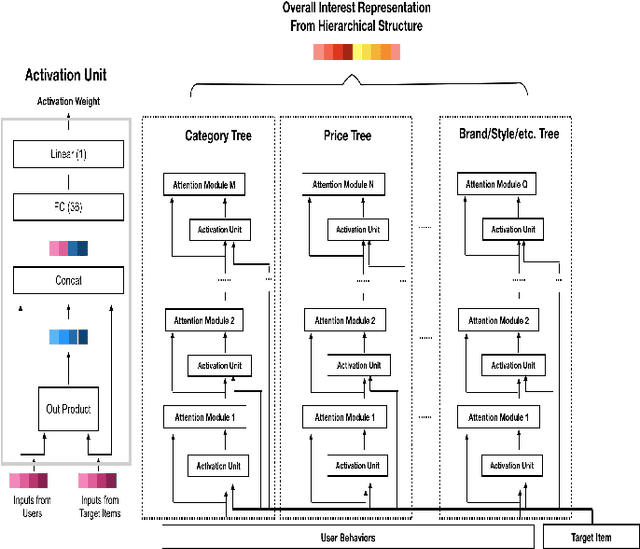

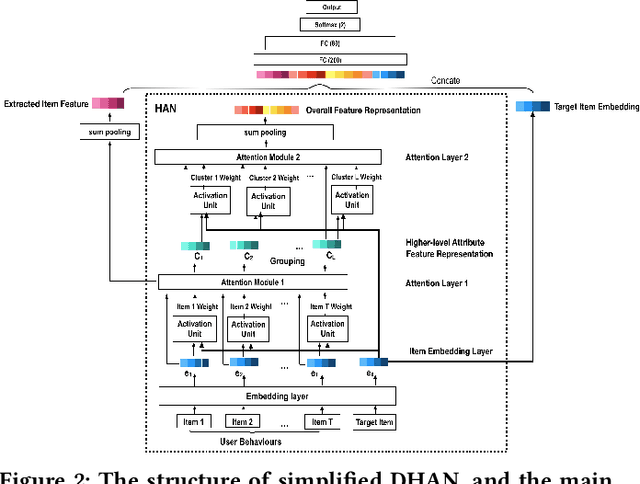

Abstract:Deep Interest Network (DIN) is a state-of-the-art model which uses attention mechanism to capture user interests from historical behaviors. User interests intuitively follow a hierarchical pattern such that users generally show interests from a higher-level then to a lower-level abstraction. Modeling such an interest hierarchy in an attention network can fundamentally improve the representation of user behaviors. We, therefore, propose an improvement over DIN to model arbitrary interest hierarchy: Deep Interest with Hierarchical Attention Network (DHAN). In this model, a multi-dimensional hierarchical structure is introduced on the first attention layer which attends to an individual item, and the subsequent attention layers in the same dimension attend to higher-level hierarchy built on top of the lower corresponding layers. To enable modeling of multiple dimensional hierarchies, an expanding mechanism is introduced to capture one to many hierarchies. This design enables DHAN to attend different importance to different hierarchical abstractions thus can fully capture user interests at different dimensions (e.g. category, price, or brand).To validate our model, a simplified DHAN has applied to Click-Through Rate (CTR) prediction and our experimental results on three public datasets with two levels of the one-dimensional hierarchy only by category. It shows the superiority of DHAN with significant AUC uplift from 12% to 21% over DIN. DHAN is also compared with another state-of-the-art model Deep Interest Evolution Network (DIEN), which models temporal interest. The simplified DHAN also gets slight AUC uplift from 1.0% to 1.7% over DIEN. A potential future work can be a combination of DHAN and DIEN to model both temporal and hierarchical interests.
 Add to Chrome
Add to Chrome Add to Firefox
Add to Firefox Add to Edge
Add to Edge